|
 RADON
FACTS RADON
FACTS
Radon is a cancer-causing, radioactive gas. You can't
see radon, smell it or taste it. But it may be a problem
in your home.
Radon is so harmful because when you breathe air
containing radon, you can get lung cancer. The Surgeon
General has warned that radon is the second leading
cause of lung cancer in the United States today. Only
smoking causes more lung cancer deaths. If you smoke
and your home has high radon levels, your risk of lung
cancer is especially high.
* Radon is estimated to cause about 21,000 lung cancer
deaths per year, according to EPA's 2003 Assessment of
Risks from Radon in Homes (EPA 402-R-03-003). The
numbers of deaths from other causes
are taken from the Centers for Disease Control and
Prevention's 2005-2006 National Center for Injury
Prevention and Control Report and 2006 National Safety
Council Reports.
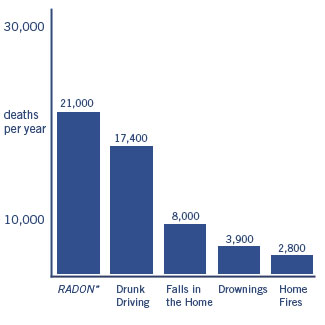
Radon comes from the natural (radioactive) breakdown of
uranium in soil, rock and water and gets into the air
you breathe. It can get into any type of building —
homes, offices, and schools — and result in a high
indoor radon level. But you and your family are most
likely to get your greatest exposure at home, where you
spend most of your time.
HOW DOES RADON GET INTO YOUR HOME?
Radon is a radioactive gas. It comes from the natural
decay of uranium that is found in nearly all soils. It
typically moves up through the ground to the air above
and into your home through cracks and other holes in the
foundation. Your home traps radon inside, where it can
build up. Any home may have a radon problem. This means
new and old homes, well-sealed and drafty homes, and
homes with or without basements.
Radon from soil gas is the main cause of radon problems.
Sometimes radon enters the home through well water (see
"Radon in Water" below). In a small number of
homes, the building materials can give off radon, too.
However, building materials rarely cause radon problems
by themselves.
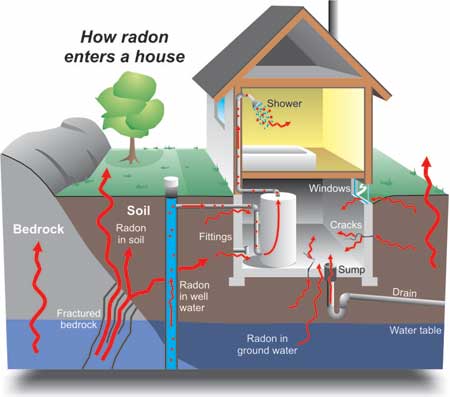 RADON
GETS IN THROUGH: RADON
GETS IN THROUGH:
* Cracks in solid floors
* Construction joints
* Cracks in walls
* Gaps in suspended floors
* Gaps around service pipes
* Cavities inside walls
* The water
supply
Nearly 1 out of every 15 homes in the U.S. is estimated
to have elevated radon levels. Elevated levels of radon
gas have been found in homes in your state. While radon
problems may be more common in some areas, any home may
have a problem. The only way to know about your home is
to test.
Radon can be found all over the U.S. Click here to see
the EPA map of high risk zones in the U.S.
RADON IN THE USA
|
|
|
EPA
Map of Radon Zones
(click map for
larger view)
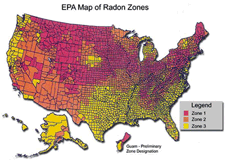
 Highest Potential
Highest Potential |
 Moderate Potential
Moderate Potential |
 Lowest Potential
Lowest Potential |
|
New England States
Radon Zones
(click maps for
larger view)


 

 |
TESTING FOR RADON
Testing is the only way to know if you and your family
are at risk from radon. EPA and the Surgeon General
recommend testing all homes below the third floor for
radon. Testing is inexpensive and easy — it should only
take a few minutes of your time. Millions of Americans
have already tested their homes for radon.
There are Two General Ways to Test for Radon:
SHORT-TERM TESTING:
The quickest way to test is with short-term tests.
Short-term tests remain in your home for two days to 90
days, depending on the device. "Charcoal canisters,"
"alpha track," "electret ion chamber," "continuous
monitors," and "charcoal liquid scintillation" detectors
are most commonly used for short-term testing. Because
radon levels tend to vary from day to day and season to
season, a short-term test is less likely than a
long-term test to tell you your year-round average radon
level. If you need results quickly, however, a
short-term test followed by a second short-term test may
be used to decide whether to fix your home.
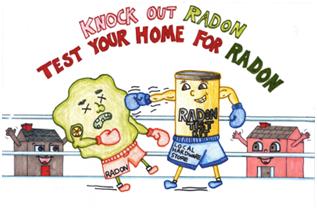 How
To Use a Test Kit: How
To Use a Test Kit:
Follow the instructions that come with your test kit. If
you are doing a short-term test, close your windows and
outside doors and keep them closed as much as possible
during the test. Heating and air-conditioning system
fans that re-circulate air may be operated. Do not
operate fans or other machines which bring in air from
outside. Fans that are part of a radon-reduction system
or small exhaust fans operating only for short periods
of time may run during the test. If you are doing a
short-term test lasting just 2 or 3 days, be sure to
close your windows and outside doors at least 12 hours
before beginning the test, too. You should not
conduct short-term tests lasting just 2 or 3 days during
unusually severe storms or periods of unusually high
winds. The test kit should be placed in the lowest
lived-in level of the home (for example, the basement if
it is frequently used, otherwise the first floor). It
should be put in a room that is used regularly (like a
living room, playroom, den or bedroom) but not
your kitchen or bathroom. Place the kit at least 20
inches above the floor in a location where it won't be
disturbed - away from drafts, high heat, high humidity,
and exterior walls. Leave the kit in place for as long
as the package says. Once you've finished the test,
reseal the package and send it to the lab specified on
the package right away for analysis. You should receive
your test results within a few weeks.
LONG-TERM TESTING:
Long-term tests remain in your home for more than 90
days. "Alpha track" and "electret" detectors are
commonly used for this type of testing. A long-term test
will give you a reading that is more likely to tell you
your home's year-round average radon level than a
short-term test.
EPA Recommends the Following Testing Steps:
Step 1. Take a short-term test. If your result is 4 pCi/L
or higher, take a follow-up test (Step 2) to be sure.
Step 2. Follow up with either a long-term test or a
second short-term test:
·
For a better understanding of your year-round average
radon level, take a long-term test.
·
If you need results quickly, take a second short-term
test.
The higher your initial short-term test result, the more
certain you can be that you should take a short-term
rather than a long-term follow up test. If your first
short-term test result is more than twice EPA's 4 pCi/L
action level, you should take a second short-term test
immediately.
Step 3. If you followed up with a long-term test: Fix
your home if your long-term test result is 4 pCi/L or
more. If you followed up with a second short-term test:
The higher your short-term results, the more certain you
can be that you should fix your home.
Consider fixing your home if the average of your first
and second test is 4 pCi/L or higher.
What Your Test
Results Mean
Test your home now and save your results. If you find
high radon levels, fix your home before you decide to
sell it.
The average indoor radon level is estimated to be about
1.3 pCi/L, and about 0.4 pCi/L of radon is normally
found in the outside air. The U.S. Congress has set a
long-term goal that indoor radon levels be no more than
outdoor levels. While this goal is not yet
technologically achievable in all cases, most homes
today can be reduced to 2 pCi/L or below.
Sometimes short-term tests are less definitive about
whether or not your home is above 4 pCi/L. This can
happen when your results are close to 4 pCi/L. For
example, if the average of your two short-term test
results is 4.1 pCi/L, there is about a 50% chance that
your year-round average is somewhat below 4 pCi/L.
However, EPA believes that any radon exposure carries
some risk - no level of radon is safe. Even radon levels
below 4 pCi/L pose some risk, and you can reduce your
risk of lung cancer by lowering your radon level.
If your living patterns change and you begin occupying a
lower level of your home (such as a basement) you should
retest your home on that level.
Even if your test result is below 4 pCi/L, you may want
to test again sometime in the future.
RADON IN WATER
 There are two main sources for the radon in your home's
indoor air, the soil and the water supply. Compared to
radon entering the home through water, radon entering
your home through the soil is usually a much larger
risk. There are two main sources for the radon in your home's
indoor air, the soil and the water supply. Compared to
radon entering the home through water, radon entering
your home through the soil is usually a much larger
risk.
The radon in your water supply poses an inhalation risk
and an ingestion risk. Research has shown that your risk
of lung cancer from breathing radon in air is much
larger than your risk of stomach cancer from swallowing
water with radon in it. Most of your risk from radon in
water comes from radon released into the air when water
is used for showering and other household purposes.
Radon in your home's water is not usually a problem when
its source is surface water. A radon in water problem is
more likely when its source is ground water, e.g. a
private well or a public water supply system that uses
ground water. If you are concerned that radon may be
entering your home through the water and your water
comes from a public water supply, contact your water
supplier.
If you've tested the air in your home and found a radon
problem, and your water comes from a well, have your
water tested.
If you've tested your private well and have a radon in
water problem, it can be fixed. Your home's water supply
can be treated in two ways. Point-of-entry treatment can
effectively remove radon from the water before it enters
your home. Point-of-use treatment devices remove radon
from your water at the tap, but only treat a small
portion of the water you use and are not effective in
reducing the risk from breathing radon released into the
air from all water used in the home.
HOW TO LOWER THE
RADON LEVELS IN YOUR HOME
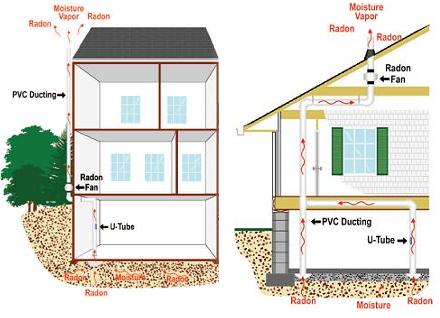 Radon and Home Renovations Radon and Home Renovations
If you are planning any major structural renovation,
such as converting an unfinished basement area into
living space, it is especially important to test the
area for radon before you begin the renovation. If your
test results indicate a radon problem, radon-resistant
techniques can be inexpensively included as part of the
renovation. Because major renovations can change the
level of radon in any home, always test again after work
is completed.
Since there is no known safe level of radon, there can
always be some risk. But the risk can be reduced by
lowering the radon level in your home.
There are several proven methods to reduce radon in your
home, but the one primarily used is a vent pipe system
and fan, which pulls radon from beneath the house and
vents it to the outside. This system, known as a soil
suction radon reduction system, does not require major
changes to your home. Sealing foundation cracks and
other openings makes this kind of system more effective
and cost-efficient. Similar systems can also be
installed in houses with crawl spaces. Radon contractors
can use other methods that may also work in your home.
The right system depends on the design of your home and
other factors.
The cost of reducing radon in your home depends on how
your home was built and the extent of the radon problem.
Most homes can be fixed for about the same cost as other
common home repairs. The cost to fix can vary widely;
consult with your state radon office or get one or more
estimates from qualified mitigators. The cost is much
less if a passive system was installed during
construction.
Note: The diagram is a composite view of several
mitigation options. The typical mitigation system
usually has only one pipe penetration through the
basement floor; the pipe may also be installed on the
outside of the house.
Lowering high radon levels requires technical knowledge
and special skills. You should use a contractor who is
trained to fix radon problems. A qualified contractor
can study the radon problem in your home and help you
pick the right treatment method.
Most homes can be fixed for about the same cost as other
common home repairs.
You should also test your home again after it is fixed
to be sure that radon levels have been reduced. Most
soil suction radon reduction systems include a monitor
that will indicate whether the system is operating
properly. In addition, it's a good idea to retest your
home every two years to be sure radon levels remain low.
RADON MYTHS
 MYTH: Scientists aren't sure radon really is a problem. MYTH: Scientists aren't sure radon really is a problem.
FACT: Although some
scientists dispute the precise number of deaths due to
radon, all the major health organizations (like the
Centers for Disease Control and Prevention, the American
Lung Association and the American Medical Association)
agree with estimates that radon causes thousands of
preventable lung cancer deaths every year. This is
especially true among smokers, since the risk to smokers
is much greater than to non-smokers.
MYTH: Radon testing is difficult, time consuming and
expensive.
FACT: Radon testing
is easy. You can test your home yourself or hire
a qualified radon test company.
Either approach takes only a small amount of time and
effort.
MYTH: Homes with radon problems can't be fixed.
FACT: There are
simple solutions to radon problems in homes. Hundreds of
thousands of homeowners have already fixed radon
problems in their homes. Most homes can be fixed for
about the same cost as other common home repairs; check
with one or more qualified mitigators. Call your
state radon office
for help in identifying qualified mitigation
contractors.
MYTH: Radon affects only certain kinds of homes.
FACT: House
construction can affect radon levels. However, radon can
be a problem in homes of all types: old homes, new
homes, drafty homes, insulated homes, homes with
basements, homes without basements. Local geology,
construction materials, and how the home was built are
among the factors that can affect radon levels in homes.
MYTH: Radon is only a problem in certain parts of the
country.
FACT: High radon
levels have been found in every state. Radon problems do
vary from area to area, but the only way to know your
radon level is to test.
MYTH: A neighbor's test result is a good indication of
whether your home has a problem.
FACT: It's not. Radon
levels can vary greatly from home to home. The only way
to know if your home has a radon problem is to test it.
MYTH: Everyone should test their water for radon.
FACT: Although radon
gets into some homes through water, it is important to
first test the air in the home for radon. If your water
comes from a public water supply that uses ground water,
call your water supplier. If high radon levels are found
and the home has a private well, call the Safe Drinking
Water Hotline at 1 800-426-4791 for information on
testing your water.
MYTH: It's difficult to sell homes where radon problems
have been discovered.
FACT: Where radon
problems have been fixed, home sales have not been
blocked or frustrated. The added protection is sometimes
a good selling point.
MYTH: I've lived in my home for so long, it doesn't make
sense to take action now.
FACT: You will reduce
your risk of lung cancer when you reduce radon levels,
even if you've lived with a radon problem for a long
time.
MYTH: Short-term tests can't be used for making a
decision about whether to fix your home.
FACT:
A short-term
test, followed by a second short-term test* can be used
to decide whether to fix your home. However, the closer
the average of your two short-term tests is to 4 pCi/L,
the less certain you can be about whether your
year-round average is above or below that level. Keep in
mind that radon levels below 4 pCi/L still pose some
risk. Radon levels can be reduced in most homes to 2 pCi/L
or below.
* If the radon test is part of a real estate
transaction, the result of two short-term tests can be
used in deciding whether to mitigate. For more
information, see EPA's "Home
Buyer's and Seller's Guide to Radon".
RADON HOTLINES
1-800-SOS-RADON
(1-800-767-7236)*
National Radon Hotline Purchase radon test kits
by phone.
1-800-55RADON
(1-800-557-2366)*
National Radon Helpline Get live help for your
radon questions.
1-800-644-6999*
National Radon Fix-It Line For general
information on fixing or reducing the radon level in
your home.
1-800-426-4791
Safe Drinking Water Hotline,
operated under contract to EPA. For information on
testing, treatment, radon in water, and drinking water
standards.
|
